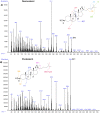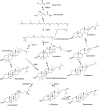Beneficial sterols in selected edible insects and their associated antibacterial activities
- PMID: 37402875
- PMCID: PMC10319837
- DOI: 10.1038/s41598-023-37905-4
Beneficial sterols in selected edible insects and their associated antibacterial activities
Abstract
Edible insects are increasingly gaining popularity as research reveals multiple benefits. However, the rediscovery of natural products from insects as medicinal agents has received limited attention. This study aimed at evaluating the diversity of sterols in extracts of nine edible insects and potential antibacterial activities. Dichloromethane extracts of these insects were analyzed using gas chromatography-mass spectrometry to identify important sterols, followed by evaluation of their anti-bacterial activities. Nineteen sterols were identified with the highest recorded in African fruit beetle [Pachnoda sinuata (47.37%)], crickets [Gryllus bimaculatus (36.84%) and Scapsipedus icipe (31.58%)]. Cholesterol was the most prevalent, except in black soldier fly (Hermetia illucens). Bioactivity revealed S. icipe as the most potent extract against Escherichia coli and Bacillus subtilis whereas G. bimaculatus was highest against Methicillin-susceptible Staphylococcus aureus 25923. These findings unravels the diversity of sterols in edible insects and their possible application in food, pharmaceutical and cosmetic industries.
© 2023. The Author(s).
Conflict of interest statement
The authors declare no competing interests.
Figures










Similar articles
-
Effects of Edible Insects on the Mycelium Formation of Cordyceps militaris.Pak J Biol Sci. 2021 Jan;24(8):881-887. doi: 10.3923/pjbs.2021.881.887. Pak J Biol Sci. 2021. PMID: 34486355
-
Mycotoxins on edible insects: Should we be worried?Food Chem Toxicol. 2023 Jul;177:113845. doi: 10.1016/j.fct.2023.113845. Epub 2023 May 19. Food Chem Toxicol. 2023. PMID: 37209938
-
Integrating temperature-dependent life table data into Insect Life Cycle Model for predicting the potential distribution of Scapsipedus icipe Hugel & Tanga.PLoS One. 2019 Sep 25;14(9):e0222941. doi: 10.1371/journal.pone.0222941. eCollection 2019. PLoS One. 2019. PMID: 31553778 Free PMC article.
-
Why for feed and not for human consumption? The black soldier fly larvae.Compr Rev Food Sci Food Saf. 2020 Sep;19(5):2747-2763. doi: 10.1111/1541-4337.12609. Compr Rev Food Sci Food Saf. 2020. PMID: 33336973 Review.
-
Dietary and Therapeutic Benefits of Edible Insects: A Global Perspective.Annu Rev Entomol. 2024 Jan 25;69:303-331. doi: 10.1146/annurev-ento-020123-013621. Epub 2023 Sep 27. Annu Rev Entomol. 2024. PMID: 37758222 Review.
Cited by
-
Edible caterpillars (Gonimbrasia belina and Gynanisa maja) as emerging source of nutrients and bioactive compounds.Future Foods. 2024 Dec;10:None. doi: 10.1016/j.fufo.2024.100478. Future Foods. 2024. PMID: 39698372 Free PMC article.
-
Insect Lipids as Novel Source for Future Applications: Chemical Composition and Industry Applications-A Comprehensive Review.Food Sci Nutr. 2025 Jul 20;13(7):e70553. doi: 10.1002/fsn3.70553. eCollection 2025 Jul. Food Sci Nutr. 2025. PMID: 40688597 Free PMC article. Review.
-
Unlocking the Potential of Substrate Quality for the Enhanced Antibacterial Activity of Black Soldier Fly against Pathogens.ACS Omega. 2024 Feb 12;9(7):8478-8489. doi: 10.1021/acsomega.3c09741. eCollection 2024 Feb 20. ACS Omega. 2024. PMID: 38405442 Free PMC article.
-
The Invisible Threat of Antibiotic Resistance in Food.Antibiotics (Basel). 2025 Mar 1;14(3):250. doi: 10.3390/antibiotics14030250. Antibiotics (Basel). 2025. PMID: 40149061 Free PMC article. Review.
-
Cranberry Oil: A Potent Natural Intimate Care Ingredient Displaying Antioxidant and Anti-Inflammatory Effects and Promoting Beneficial Vaginal Lactobacillus.Int J Mol Sci. 2025 Feb 28;26(5):2176. doi: 10.3390/ijms26052176. Int J Mol Sci. 2025. PMID: 40076798 Free PMC article.
References
Publication types
MeSH terms
Substances
LinkOut - more resources
Full Text Sources

